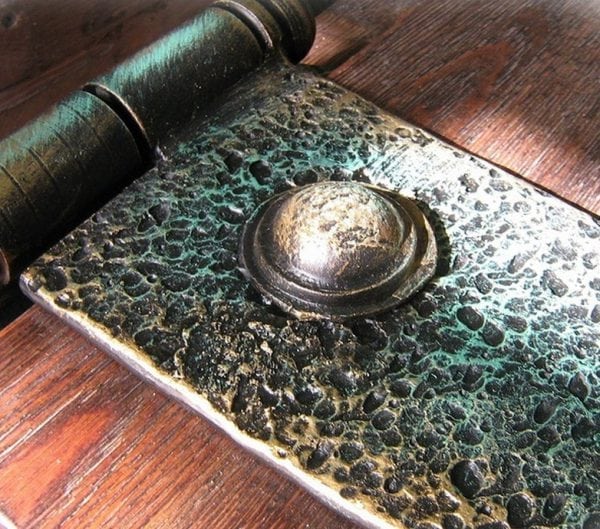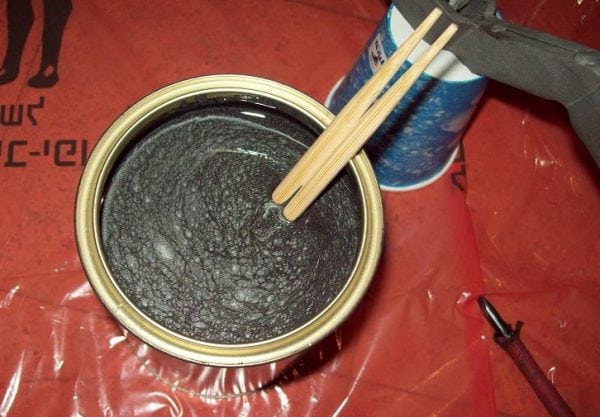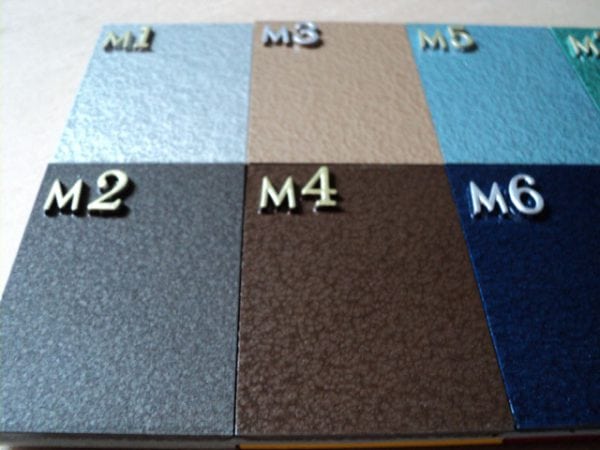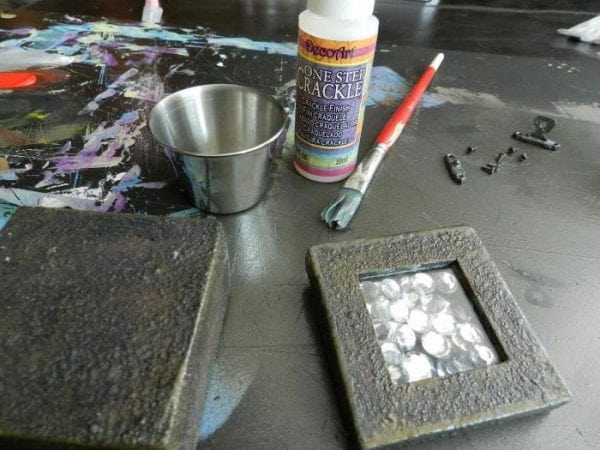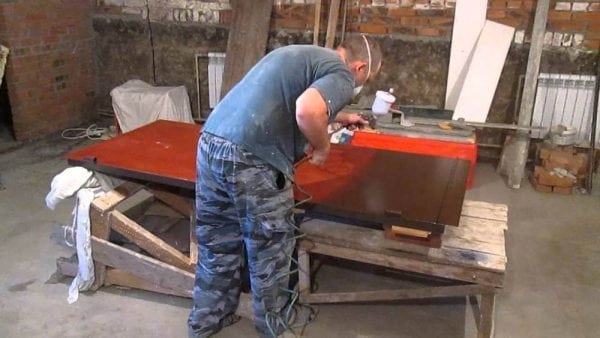A wide selection of finishing materials, including paints and varnishes, allows you to choose a coating that meets all the requirements, not only in quality and appearance, but also in cost. Hammer paint deserves special attention. It got its name thanks to an interesting texture, similar to hand stamping, which is obtained after application.
- Reasons for popularity
- Composition and features
- Hammer Paint Colors
- Main advantages
- Scope of use
- How to apply
- Application Methods
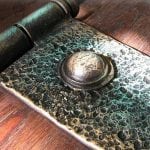
Typically, paint with a hammer effect is used to decorate metal structures: furniture, gates, car bodies and much more. Due to its high corrosion resistance, it can be applied directly to rust, without subjecting the surface to cleaning and priming with enamel, as is the case with other types of coatings. In addition to metal products, hammer enamel is perfect for woodwork, painting the outside of industrial facilities.
to contents ↑Reasons for popularity
Initially, hammer paint was used to process equipment for production and laboratories. At that time there was no need to develop a wide color gamut of coatings, since the decorative side of this issue was unimportant. We used the most affordable pigment, so all products treated with this paint had a gray color.
Paint has gained popularity due to its high anti-corrosion properties and resistance to external influences. Due to this, it has become widespread and is now used gate painting, car parts and other metal products most susceptible to damage.
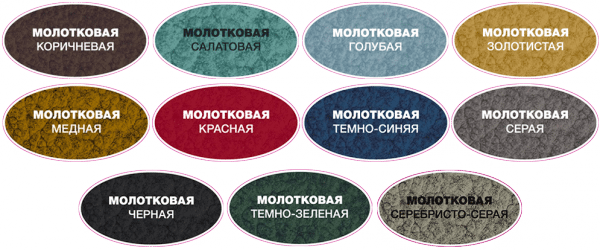
Composition and features
Hammer paint is designed to protect metal products used in industry, manufacturing and other areas where they are constantly exposed. For its manufacture, alkyd and epoxy substances are used, which provides exceptional characteristics.
The silicone resins and metallic pigments included in the composition guarantee unique durability, ease of application and excellent adhesion to the surface. Due to these components, the density of the paint increases significantly, and anti-corrosion properties are achieved.
The coating strengths present in the composition increase the coating strength even more: fine glass, aluminum powder and others. Due to this, not only surface resistance is achieved and adhesion is increased, but also a unique texture is obtained, similar to hand-stamping on metal. That is why this tool has the ability to mask minor defects of the treated surface. Also, various silicones and “aluminum flakes” are added to it, which together help to improve texture and increase the ability to repel moisture.
to contents ↑Hammer Paint Colors
Hammer paints are primarily for protection, not decor, so they were originally produced in black and gray. The market dictates its conditions and manufacturers began to include color pigments in the composition of the material, which expanded the color palette. But the metallic luster and texture of the painted surface impose certain restrictions on the color of the assortment range - these are mainly dark and pastel tones, although you can get absolutely any shade if you wish.
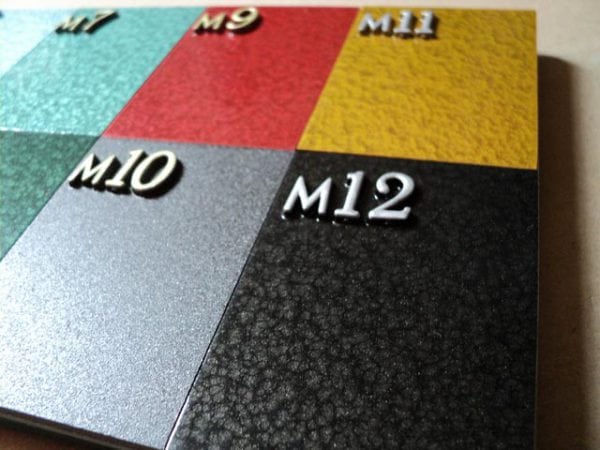
Most manufacturers produce the following popular shades:
- the black;
- Gray;
- silver gray;
- brown;
- red;
- copper;
- golden;
- Navy blue;
- blue;
- dark green;
- light green.
Main advantages
This material is characterized by a considerable number of advantages. Most of them owe its composition:
- One of the leading characteristics is the resistance of the coating to temperature extremes - it can withstand heating up to +80 ° C.
- In the event that hammer paint should be applied to a surface covered with rust, there is no need to subject it to cleaning and priming in advance. This simplifies the process of painting.
- Another advantage is the quick drying of the composition. The fastest is considered an aerosol. Within two hours after application, the coating will harden and there will be no stickiness on it. This property is especially important when processing a car body and daily used gate.
- A high degree of resistance to external influences - temperature extremes and high humidity, as well as immunity to vibrational vibrations - determine the use of this paint for the treatment of equipment surfaces, garage doors, metal parts of fences and other household buildings.
- Hammer paint guarantees protection of steel against corrosion for up to 8 years.
- Developed special heat-resistant types of this tool. However, they are still inferior to special refractory compounds for painting metal, which are widely used in the painting of fireproof cabinets and armored doors.
- Hammer enamel is absolutely safe for humans and after complete drying does not emit any harmful substances. It is devoid of the unpleasant odor characteristic of many other paints and varnishes. These conditions allow you to freely use it for internal work.
- Application is possible in various ways: brush, roller, as an aerosol. Although the latter option is more expensive, since it does not allow you to adjust the consumption per 1 m2.
- The wide color gamut of this paint allows you to choose the right shade for painting any product - from the garage door to the car body and the metal rack.
- Manufacturers claim that the treated surface will not lose its color for at least three years.
- Garage doors treated with a hammer type of coating will be much less susceptible to contamination than ordinary metal paint. Paint consumption is approximately the same.
Scope of use
Due to its exclusive qualities, hammer enamel is widely used in various fields of production. It is used to cover numerous types of structures:
- industrial equipment and machine cases;
- electrical panels and specialized appliances;
- metal building structures;
- safes, metal cabinets, shelving and a variety of office furniture;
- fences and gates;
- hammer painting is often used to decorate products made of glass, hard plastic and tile.
to contents ↑
How to apply
Since this coating is used in various fields, it is used to process numerous types of surfaces, including rust-coated metal, the painting technique may differ in different situations. It is better to read the instructions explaining how to paint with a hammer paint in cases that are most common.
First of all, the product must be properly prepared.
If the metal is new, then before starting work it is necessary to get rid of the layer of factory grease present on the surface.
To do this, it is thoroughly washed at least twice with a solvent - most often White Spirit is taken. After this, thoroughly wipe with acetone. If the product is very smooth, it is recommended to sand it to facilitate adhesion to the coating.
When painting with your own hands the elements on which the paintwork material is already present, it is better to first remove the lagging parts, then rinse with a weak solution of washing powder and clean water, and then dry.
For decorative processing of galvanized, aluminum or cast-iron elements, first apply enamel primer. This must also be done in the preparation of copper, tin, and lead products.
Before painting a wooden surface, it is also better to treat it with acrylic primer-enamel so that the composition does not penetrate the pores, which will lead to a violation of the texture.
to contents ↑Application Methods
There are a lot of methods for painting surfaces with hammer paint. This can be done with a brush, roller, aerosol spray can, pneumatic spray or airless method. The layer of the applied composition must be at least 100 microns, this provides reliable protection, but also determines a decent consumption per 1 m2.
The use of aerosol is very convenient in cases where it is planned to carry out painting work on a small surface. It is unlikely that this method is suitable for decorating a gate or a car body - in these cases it is better to use a spray gun. It is also convenient to use an aerosol when tinting small elements. Before staining, shake the can for about three minutes to mix the contents. In the case of an aerosol, it is not easy to keep track of the paint consumption, so three to four layers are applied, the interval between which is at least 15 minutes.
For processing large surfaces, such as fences and gates, pneumatic spraying is used with a spray gun. In order to achieve the correct consumption of the composition with your own hands, it is important to correctly calculate the viscosity. The paint should be diluted with a solvent in such proportions as indicated in the instructions, usually 2: 1. This ratio will be correct for aerosol preparation at a temperature of +18 to +22 ° C; in other conditions, the flow rate changes.
Airless spraying is also similar to aerosol, but the material consumption will be slightly different. For the treatment of gates, bodies, bulk parts, paint is mixed with a solvent in a ratio of 9: 1.
The average consumption of hammer paint is 100 g per 1 m2, but this value may vary depending on the conditions of work.
Regardless of which application method is chosen: aerosol, airbrush, brush or roller, hammer paint will in any case demonstrate high performance. It is the best option for painting metal surfaces of various products.

